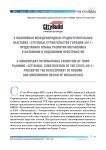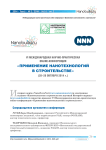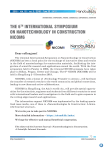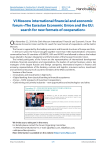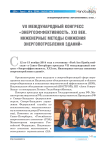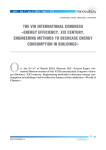Статьи журнала - Нанотехнологии в строительстве: научный интернет-журнал
Все статьи: 903
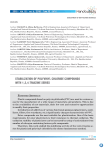
Stabilization of polyvinyl chloride compounds with 1,2,4-triazine series
Статья научная
Plastic compounds based on polyvinylchloride (PVC) are used in various areas for the manufacture of a wide range of materials and products. This is due to the availability of raw materials, their low cost and extensive opportunities to modify their properties. Introduction of additives of various functional purposes (plasticizers, stabilizers, fillers, fire retardants, etc.) significantly changes characteristics of PVC. Ester compounds are the most suitable for plasticization. One of the basic requirements for ester plasticizers is their resistance to thermal oxidation. The oxidation stability of plasticizers can be increased by using of antioxidants from number of nitrogen-containing heterocyclic compounds. Therefore, this work studied the stabilizing activity of the 1,2,4-triazine series for plasticized polyvinyl chloride by the chemo luminescence method. Having analyzed the results of experiments the authors found out that compositions obtained with the use of new additives - octylphenoxypropyl phthalates and of the 1,2,4-triazine series, acquire high performance properties that leads to increased service life. The results show that compounds of the 1,2,4-triazine series reduce the thermo-oxidative destruction of plasticized polyvinyl chloride. Thus, the use of the 1,2,4-triazine series as anti-oxidant stabilizers makes it possible to increase the durability of PVC plasticates.
Бесплатно
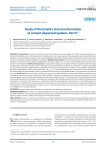
Study of the kinetics structure formation of cement dispersed systems. Part II
Статья научная
Introduction. The study of the kinetics structure formation is rarely the subject of a careful study. Although it is important for materials used to create elements of building structures, energy elements, thermoelements and materials for other purposes. The article proposes refinements of the methodology for determining the parameters of the kinetics structure formation of cement composites, including modified compositions. Methods and materials. The structure formation of cement systems with plasticizers, microsized mineral additives (hydrosilicates of barium, copper, iron and zinc) and nanosized particles of zinc hydrosilicates has been studied. Results and discussion. It is proposed to single out two stages of initial structure formation: the stage of setting the cement paste and the stage of hardening. It was found that the strength of the material at the stage of hardening should be influenced by an additional factor, depending on the type of the introduced substance. A strong negative relationship between the parameters α and n of the equation R(t) = Rmax(1–eatn) at the hardening stage was confirmed. The trends identified at the setting stage also demonstrated, namely: an increase in the rate of structure formation leading to the formation of a less dense structure. Conclusions. An analysis of the change in the value of the internal dimension of the system during the transition from the stage of setting to the stage of hardening made it possible to identify two trajectories of the system development. The first trajectory appears only by combining the elements of the structure (trajectory No. 1). Preservation of the characteristic dimensions of structural elements, but an increase in the proportion of elements with small dimensions (when the conditions that prevent the combination of elements of the structure are realized) describes the second trajectory (trajectory No. 2). The implementation of trajectory No. 2 is typical for compositions which the structure formation of cement stone is carried out in the presence of Melment F15G plasticizer or microsized particles of copper or zinc. For other studied compositions, structure formation is proceeding with the enlargement of structural elements.
Бесплатно
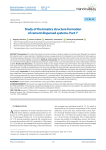
Study of the kinetics structure formation of cement dispersed systems. Part i
Статья научная
Introduction. The study of the kinetics structure formation is rarely the subject of a careful study. Although it is important for materials used to create elements of building structures, energy elements, thermoelements and materials for other purposes. The article proposes refinements of the methodology for determining the parameters of the kinetics structure formation of cement composites, including modified compositions. Methods and materials. The structure formation of cement systems with plasticizers, microsized mineral additives (hydrosilicates of barium, copper and zinc) and nanosized particles of zinc hydrosilicates has been studied. Results and discussion. It is proposed to single out two stages of initial structure formation: the stage of setting the cement paste and the stage of hardening. The selection of the setting stage is connected with the natural laws of the development of natural systems, namely, the initial formation of a structural grid obeys an exponential law. Moment of time when a deviation from this law is observed is the time of occurrence of spatial and/or prescription difficulties that hinder the exponential development of the system. Conclusions. A strong negative relationship between the parameters φ and β of the equation H(t) = a exp(φtβ) has been established. These parameters characterize the rate of structure formation at the setting stage (parameter φ) and the density of the structure (parameter β or the internal dimension Di, 0 associated with it). The presence of such a negative relationship indicates the inadvisability of accelerating the processes of structure formation at the stage of setting. This is supported by a strong positive relationship between the period of initial structure formation t0,s1 and the strength of the material R28
Бесплатно
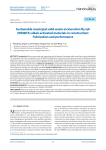
Статья научная
Introduction. Recent years have seen a pressing need to dispose of municipal solid waste due to rapid urbanization. The municipal solid waste incineration fly ash (MSWIFA) produced from solid waste incineration power plant exhibits pozzolanic properties and poses concern of toxicity leaching when used directly as building materials. This paper presents an alkali-activation method to produce sustainable alkali-activated MSWIFA materials (AAFMs) with various MSWIFA dosages and investigate the corresponding fabrication and performance. Materials and Methods. Composited alkali activators activate the MSWIFA with constant alkalinity of 5% and the molar ratio of Si/Na = 0.86. The resulting geopolymers' bulk densities, mineral composites, morphology, and compression strength are thoroughly examined. Results and discussions. Results show that the use of MSWIFA may lead to more loose structures because the bubbles are generated from metallic aluminum and alkali activators. Additionally, the production of multiple crystals also accounts for increasing porosity. The generated multi-crystals such as Sylvite, Halite, Hydrocalumite, Calcium Hydroxide, and Ettringite are further detected from the morphology and mineral analysis. Furthermore, compression tests and toxicity characteristic leaching procedures (TCLP) are conducted to investigate the mechanical performance and heavy metals solidification performance of AAFMs, with an optimal compression strength of 19.99MPa at 28 days for AAFM-10 while toxicity leaching is subject to regularity limits. Conclusions. This study shows that great potential of using the alkali-activation method to recycle hazardous municipal solid fly ash into construction materials with both ecological safety and high performance.
Бесплатно
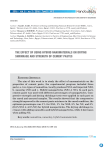
The effect of using hybrid nanomaterials on drying shrinkage and strength of cement pastes
Статья научная
The aim of this work is to study the effect of nanomaterials on the properties of cement paste, the experimental program included three parts: a- two types of nanosilica, locally produced NS1 and imported NS2, b- nanoclay (NC) and c- Hybrid nanoparticles (NS1 & NC). In each part, cement paste was used with different percentages of nanoparticles. Compressive strength and drying shrinkage tests were applied in each part on the cured and uncured samples. The results showed that the compressive strength improved in the cement paste mixtures in the cured condition, the optimum percentages was 1% for NS1, 1% for NS2, 5% for NC, and 5% (0.5%NS1 & 4.5%NC) for hybrid nanoparticles. The drying shrinkage increases with adding nanosilica and hybrid nanoparticles, while it decreases when adding NC.
Бесплатно
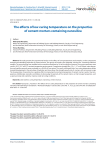
The effects of low curing temperature on the properties of cement mortars containing nanosilica
Статья научная
This study presents the experimental results on the effects of curing temperature and nanosilica, on the compressive strength and absorbing properties of cement mortars. Two groups of mortars were prepared, with the first containing reference samples. The second group was modified with a nanosilica admixture by 3% of the weight of cement. The mortar specimens were cured in 20оC, 10оC and 5оC constant temperature environments. Compressive strength after 12 h, 1, 2, 7 and 28 days, water absorption and capillary porosity were evaluated on a 40×40×40 mm prism. The results confirmed that a low curing temperature delays strength development in the early days of hydration and slows down the strength growth rate of mortars, with an increase in age. The incorporation of nanosilica has a positive effect in improving the mechanical properties of cement mortars cured at low temperatures. Additionally, nanosilica contributes to decreasing the porosity of the cement matrix, so that transport properties, such as open porosity and sorptivity, improve under all curing conditions.
Бесплатно
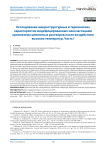
Статья научная
This study presents an investigation of the effects of high temperature on the thermal and microstructural properties of cement mortars modified with nanosilica. In the first stage of the research, the effects of nanosilica (NS) and silica fume (SF) on the hydration and compressive strength of cementitious composites were compared. In the second stage, four different types of cement mortars, containing an optimal dosage of NS, were produced. Two of them contained a normal weight aggregate (quartz or limestone), whilst two contained a heavy weight aggregate (barite or magnetite). Specimens without NS were produced for control purposes. The specimens were exposed to 300, 450, 600 and 800°C, with their post-heating properties - including thermal conductivity, specific heat, solvent absorption and cracking behavior - analyzed. The results show that NS exhibits significantly higher reactivity with cement than SF. NS accelerates the cement hydration process and contributes more significantly to the 28 and 365 day compressive strength of mortar, as compared to SF...
Бесплатно
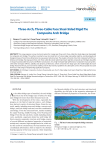
Three-Arch, Three-Cable Face Steel-Sided Rigid Tie Composite Arch Bridge
Статья научная
This essay proposes a new structural system for a large span three-arch, three-cable face steel edge main beamrigid tie composite arch bridge. The authors invented a new structural form of a steel edge main girder rigid tie, and developed and designed a key arch-bar three-dimensional six-way space node structure. The analysis of results show that: compared with the traditional arch bridge, the large span three-arch three-cable face steel-sided main beam rigid ties composite arch bridgeis beautiful in shape, hasareasonable structure and efficient construction. It is a high-strength, high-performance composite structural system, with better strength, stiffness, stability and dynamic performance, which overcomes the large span ultra-wide bridge deck arch bridge horizontal thrust, poor transverse stability, and the key technical problems of acable joint control. The proposed structural form has a wide range of engineering application prospects.
Бесплатно
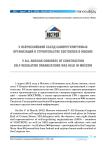
V Всероссийский съезд саморегулируемых организаций в строительстве состоялся в Москве
Статья обзорная
1 марта 2012 года в Москве, в Колонном зале Дома союзов, состо- ялся V Всероссийский съезд саморегулируемых организаций в строи- тельстве. В Съезде приняли участие 223 делегата с правом решающего голоса (руководители и представители саморегулируемых организа- ций - членов НОСТРОЙ), а также представители СРО с правом сове- щательного голоса и многочисленные гости - всего около 900 человек. Также на Съезде работали более 60 журналистов федеральных и регио- нальных средств массовой информации.
Бесплатно
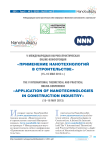
Другой
Интернет-портал NanoNewsNet (www.nanonewsnet.ru) и электронное издание «Нанотехнологии в строительстве: научный Интернет-журнал» (www.nanobuild.ru) совместно проводят V Международную научно-практическую online-конференцию «Применение нанотехнологий в строительстве».
Бесплатно

Другой
Интернет-портал NanoNewsNet (www.nanonewsnet.ru) и электронное издание «Нанотехнологии в строительстве: научный Интернет-журнал» (www.nanobuild.ru) совместно провели V Международную научно-практическую online-конференцию «Применение нанотехнологий в строительстве». В ней приняли участие ведущие ученые и специалисты Российской академии наук, Российской инженерной академии, Российской академии архитектуры и строительных наук, РОСНАНО, Научно-технического центра прикладных нанотехнологий (г. Санкт-Петербург), Международной инженерной академии, Международного союза экспертов и лабораторий по испытанию строительных материалов, систем и конструкций (РИЛЕМ), руководители и специалисты организаций и предприятий, ученые, преподаватели вузов, сотрудники НИИ и научных центров из различных регионов России, стран ближнего и дальнего зарубежья.
Бесплатно
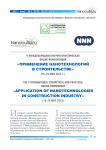
Другой
Интернет-портал NanoNewsNet (www.nanonewsnet.ru) и электронное издание «Нанотехнологии в строительстве: научный Интернет-журнал» (www.nanobuild.ru) совместно проводят V Международную научно-практическую online-конференцию «Применение нанотехнологий в строительстве».
Бесплатно
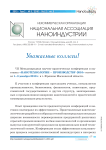
VII Международная научно-практическая конференция и выставка «Нанотехнологии - производству-2010»
Другой
Бесплатно
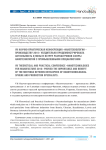
Статья
Резюме. VII Научно-практическая конференция «Нанотехнологии - производству 2010», проходившая с 1 по 3 декабря в наукограде Фрязино, собрала ведущих ученых и специа- листов различных отраслей промышленности из России, Украины, Казахстана, Латвии и Германии, заинтересованных в практическом внедрении достижений нанотехнологий и создании производств конкурентоспособной продукции на их основе.
Бесплатно

